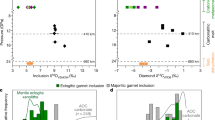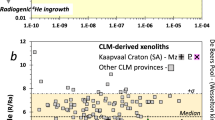Abstract
Subduction zones modulate the global carbon cycle. Carbon is transported into the mantle by the subducting slab and returned to the surface by degassing at arc volcanoes above the subduction zone1,2. However, the mechanisms for the transfer of carbon from the subducting slab and sediments into the overlying mantle wedge are poorly understood. Decarbonation—a metamorphic reaction between silicate and carbonate minerals that releases CO2—was thought to be the primary mechanism. Yet, thermodynamic models show that decarbonation occurs at much greater pressures and temperatures than those found in typical subduction zones3,4,5,6. Carbon should therefore be retained in the slab and transported to great depths in the mantle, rather than supply the arc volcanoes. Here we identify diamonds in ultrahigh-pressure rocks from the Italian western Alps that have an oceanic origin. We assess the geochemistry of diamond-bearing fluid inclusions and find that they contain bicarbonate, carbonate and sulphate ions, silica monomers, and crystals of carbonate and silicate. This fluid geochemistry indicates that carbon was released from the slab at relatively shallow depths through dissolution, not decarbonation. We conclude that dissolution, driven by fluids released from the subducted slab, is an important mechanism for the transfer of carbon into the mantle and ultimately back into the atmosphere, helping to balance the carbon flux.
This is a preview of subscription content, access via your institution
Access options
Subscribe to this journal
Receive 12 print issues and online access
$259.00 per year
only $21.58 per issue
Buy this article
- Purchase on Springer Link
- Instant access to full article PDF
Prices may be subject to local taxes which are calculated during checkout



Similar content being viewed by others
References
Sano, Y. & Williams, S. N. Fluxes of mantle and subducted carbon along convergent plate boundaries. Geophys. Res. Lett. 23, 2749–2752 (1996).
Varekamp, J. C., Kreulen, R., Poorter, R. P. E. & Vanbergen, M. J. Carbon sources in arc volcanism, with implications for the carbon cycle. Terra Nova 4, 363–373 (1992).
Connolly, J. A. D. Computation of phase equilibria by linear programming: A tool for geodynamic modeling and its application to subduction zone decarbonation. Earth Planet. Sci. Lett. 236, 524–541 (2005).
Gorman, P. J., Kerrick, D. M. & Connolly, J. A. D. Modeling open system metamorphic decarbonation of subducting slabs. Geochem. Geophys. Geosyst. 7, Q04007 (2006).
Molina, J. F. & Poli, S. Carbonate stability and fluid composition in subducted oceanic crust: An experimental study on H2O–CO2-bearing basalts. Earth Planet. Sci. Lett. 176, 295–310 (2000).
Poli, S., Franzolin, E., Fumagalli, P. & Crottini, A. The transport of carbon and hydrogen in subducted oceanic crust: An experimental study to 5 GPa. Earth Planet. Sci. Lett. 278, 350–360 (2009).
Dobrzhinetskaya, L. F., Wirth, R. & Green, H. W. A look inside of diamond-forming media in deep subduction zones. Proc. Natl Acad. Sci. USA 104, 9128–9132 (2007).
Stöckhert, B., Duyster, J., Trepmann, C. & Massonne, H. J. Microdiamond daughter crystals precipitated from supercritical COH plus silicate fluids included in garnet, Erzgebirge, Germany. Geology 29, 391–394 (2001).
Ferrando, S., Frezzotti, M. L., Dallai, L. & Compagnoni, R. Multiphase solid inclusions in UHP rocks (Su-Lu, China): Remnants of supercritical silicate-rich aqueous fluids released during continental subduction. Chem. Geol. 223, 68–81 (2005).
Frezzotti, M. L., Ferrando, S., Dallai, L. & Compagnoni, R. Intermediate alkali–alumino-silicate aqueous solutions released by deeply subducted continental crust: Fluid evolution in UHP OH-rich topaz–kyanite quartzites from Donghai (Sulu, China). J. Petrol. 48, 1219–1241 (2007).
Manning, C. E. The chemistry of subduction-zone fluids. Earth Planet. Sci. Lett. 223, 1–16 (2004).
Philippot, P. & Selverstone, J. Trace-element-rich brines in eclogitic veins—implications for fluid composition and transport during subduction. Contrib. Mineral. Petrol. 106, 417–430 (1991).
Caciagli, N. C. & Manning, C. E. The solubility of calcite in water at 6–16 kbar and 500–800 °C. Contrib. Mineral. Petrol. 146, 275–285 (2003).
Dolejs, D. & Manning, C. E. Thermodynamic model for mineral solubility in aqueous fluids: Theory, calibration and application to model fluid-flow systems. Geofluids 10, 20–40 (2010).
Compagnoni, R. & Rolfo, F. in Ultrahigh Pressure Metamorphism Vol. 5 (eds Carswell, D. A. & Compagnoni, R.) 13–49 (European Mineralogical Union Notes in Mineralogy, 2003).
Gouzu, C., Itaya, T., Hyodo, H. & Matsuda, T. Excess 40Ar-free phengite in ultrahigh-pressure metamorphic rocks from the Lago di Cignana area, Western Alps. Lithos 92, 418–430 (2006).
Groppo, C., Beltrando, M. & Compagnoni, R. The P–T path of the ultra-high pressure Lago Di Cignana and adjoining high-pressure meta-ophiolitic units: Insights into the evolution of the subducting Tethyan slab. J. Metam. Geol. 27, 207–231 (2009).
Lapen, T. J. et al. Burial rates during prograde metamorphism of an ultra-high-pressure terrane: An example from Lago di Cignana, western Alps, Italy. Earth Planet. Sci. Lett. 215, 57–72 (2003).
Reinecke, T. Very-high-pressure metamorphism and uplift of coesite-bearing metasediments from the Zermatt–Saas Zone, Western Alps. Eur. J. Mineral. 3, 7–17 (1991).
Ferrari, A. C. & Robertson, J. Raman spectroscopy of amorphous, nanostructured, diamond-like carbon, and nanodiamond. Phil. Trans. R. Soc. A 362, 2477–2512 (2004).
Hunt, J. D., Kavner, A., Schauble, E. A., Snyder, D. & Manning, C. E. Polymerization of aqueous silica in H2O–K2O solutions at 25–200 °C and 1 bar to 20 kbar. Chem. Geol. 283, 161–170 (2011).
Mosenfelder, J. L., Schertl, H-P., Smyth, J. R. & Liou, J. G. Factors in the preservation of coesite: The importance of fluid infiltration. Am. Mineral. 90, 779–789 (2005).
Frost, D. J. & McCammon, C. A. The redox state of Earth’s mantle. Annu. Rev. Earth Planet. Sci. 36, 389–420 (2008).
Malaspina, N., Scambelluri, M., Poli, S., Van Roermund, H. L. M. & Langenhorst, F. The oxidation state of mantle wedge majoritic garnet websterites metasomatised by C-bearing subduction fluids. Earth Planet. Sci. Lett. 298, 417–426 (2010).
Kelley, K. A. & Cottrell, E. Water and the oxidation state of subduction zone magmas. Science 325, 605–607 (2009).
Carswell, D. A. & Van Roermund, H. L. M. On multi-phase mineral inclusions associated with microdiamond formation in mantle-derived peridotite lens at Bardane on Fjortoft, west Norway. Eur. J. Mineral. 17, 31–42 (2005).
De Corte, K., Cartigny, P., Shatsky, V. S., Sobolev, N. V. & Javoy, M. Evidence of fluid inclusions in metamorphic microdiamonds from the Kokchetav massif, northern Kazakhstan. Geochim. Cosmochim. Acta 62, 3765–3773 (1998).
Sokol, A. G. & Pal’yanov, Y. N. Diamond crystallization in fluid and carbonate-fluid systems under mantle P–T conditions: 2. An analytical review of experimental data. Geochem. Int. 42, 1018–1032 (2004).
Sharp, Z. D. A laser-based microanalytical method for the in situ determination of oxygen isotope ratios of silicates and oxides. Geochim. Cosmochim. Acta 54, 1353–1357 (1990).
Sharp, Z. D. Oxygen isotope geochemistry of the Al2SiO5 polymorphs. Am. J. Sci. 295, 1058–1076 (1995).
Acknowledgements
Funding provided by the Italian PRIN 2008BYTF98 (M.L.F. and R.C.) and US NSF grant EAR-0809218 (J.S. and Z.D.S.). Comments from M. Kopylova, C. Manning, and S. Poli greatly improved the manuscript.
Author information
Authors and Affiliations
Contributions
Raman analyses were carried out by M.L.F., petrographic analyses by J.S. and R.C., microprobe analyses by J.S. and stable isotope analyses by Z.D.S. Samples were collected by J.S. and R.C. All authors participated in extensive discussions and the preparation of the manuscript.
Corresponding author
Ethics declarations
Competing interests
The authors declare no competing financial interests.
Supplementary information
Supplementary Information
Supplementary Information (PDF 3188 kb)
Rights and permissions
About this article
Cite this article
Frezzotti, M., Selverstone, J., Sharp, Z. et al. Carbonate dissolution during subduction revealed by diamond-bearing rocks from the Alps. Nature Geosci 4, 703–706 (2011). https://doi.org/10.1038/ngeo1246
Received:
Accepted:
Published:
Issue Date:
DOI: https://doi.org/10.1038/ngeo1246
This article is cited by
-
Crystal structure of calcite-type Ca1–xMnxCO3 solid solution by X-ray diffraction and Raman spectroscopy
Physics and Chemistry of Minerals (2024)
-
Schistes Lustrés in a hyper-extended continental margin setting and reinterpretation of the limit between the Mont Fort and Tsaté nappes (Middle and Upper Penninics, Western Swiss Alps)
Swiss Journal of Geosciences (2023)
-
Pervasive hydrous carbonatitic liquids mediate transfer of carbon from the slab to the subarc mantle
Communications Earth & Environment (2023)
-
High-pressure melting in metapelites of a 2 Ga old subducted oceanic crust (Usagaran belt, Tanzania): implications from melt inclusions, fluid inclusions and thermodynamic modelling
Contributions to Mineralogy and Petrology (2023)
-
Tracing fluid infiltration into oceanic crust up to ultra-high-pressure conditions
Contributions to Mineralogy and Petrology (2023)



